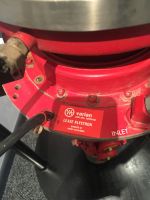- by Valerie Jones
 What was that red thing standing outside our control room? Was it a vintage flux capacitor from the movie "Back to the Future?"
What was that red thing standing outside our control room? Was it a vintage flux capacitor from the movie "Back to the Future?"
In a manner of speaking, it was a power boost of another kind.
At one of our recent productions, guests to the studio asked what it was so, as the intrepid curiousity-seekers we are, we asked around. Marty & Doc weren't available, so WFMZ-TV broadcast engineer Jeff Kuhns clued us in.
This vintage red obelisk is a type of particle accelerator, a klystron. Some are used in the transmission of broadcast signals. This Varian-brand klystron is retired from service at the mountain top station where it sat at the base of the tower to power (with a whole lot of oomph) signals to the top where they could then be broadcast long distances.
 The klystron, also called a specialized linear-beam vacuum tube, was the invented of Russell & Sigurd Varian in 1937. These Irish-American brothers were early Silicon Valley entrepreneurs, incorporating Varian Associates in 1948 to "conduct general research in the field of physical science of every kind or nature.
The klystron, also called a specialized linear-beam vacuum tube, was the invented of Russell & Sigurd Varian in 1937. These Irish-American brothers were early Silicon Valley entrepreneurs, incorporating Varian Associates in 1948 to "conduct general research in the field of physical science of every kind or nature.
Neither took the conventional path to a career that most did in their era; if you read the history at the second link below, you'll learn one was dyslexic and the other too impatient for school. Sounds like some of the most prominent "tech titans' of our day. Also described at that link are the tremendous contributions to both communications and war efforts- including applications for radar- during a critical time in our nation's history.
Here ends the broadcast engineering lesson of the day.
Read more
Russell and Sigurd Varian: Inventing the Klystron and Saving Civilization
History of Communications & Power Industries LLC (formerly Electron Device Business of Varian Associates, Inc.)
If that's not enough, check out this academic paper from Stanford University: High Power Klystrons: Theory & Practice.